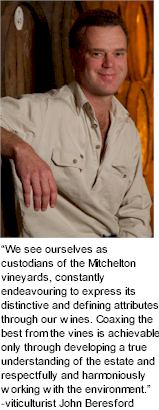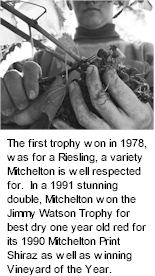


Preece chose an old grazing estate, then known as Blackwood Park, in the Nagambie district in central Victoria for its climate, soil and proximity to the waterways. The site's history stretches back to 1836, when the explorer Major Thomas Mitchell crossed the river on his 900 kilometre journey from Sydney to Melbourne, at a place called Mitchellstown. Ross Shelmerdine called his fledgling winery Mitchelton, a derivation of Mitchellstown and the vineyard's first sod was turned in 1969. Don Lewis joined Preece for the fledgling winery's first vintage in 1973, and assumed the winemaker's mantle when Preece retired in 1974. That same year, Mitchelton's winery and spectacular cellar door complex, designed by renowned Australian architect Ted Ashton and complete with 55 metre tower, was officially opened.

Highly Awarded Mitchelton has developed a reputation for consistently high quality table wines. The first trophy won in 1978, was for a Riesling, a variety Mitchelton is well respected for. In 2007, Mitchelton’s Blackwood Park Riesling celebrated 33 vintages. Mitchelton’s Shiraz wines have garnered great accolades. In a 1991 stunning double, Mitchelton won the Jimmy Watson Trophy for best dry one year old red for its 1990 Mitchelton Print Shiraz as well as winning Vineyard of the Year. Mitchelton won its first export award in 1986 and now offers its wine in 18 markets outside Australia including the UK, Europe, USA, Asia and South America.
The evolution of Mitchelton’s focus in the vineyard continues apace. Joining the Petaluma Group of wineries in 1994 and then the Lion Nathan wine group, Mitchelton’s wines continue to go from strength to strength. The investment in quality winemaking and viticulture practices that Mitchelton has always employed has seen the development of a strong mentoring culture which has woven a deep thread of Mitchelton’s home grown philosophy throughout the team.
Combining years of hands-on experience and an intimate understanding of the estate, the Mitchelton philosophy is to harness the vineyard’s potential by unlocking the best from individual blocks through innovation and attention to detail in the vineyard and the winery. Coupled with judicious use of innovative winemaking techniques, this approach gives shape and definition to the expressive qualities of the Mitchelton vineyard, creating wines of distinct personality, finesse and longevity. With the focus on individual block-targeting, each soil profile is planted with the most suitable grape variety, clonal and rootstock combination. This intensive approach nurtures individual blocks separately, allowing every vine to achieve its full potential, revealing grapes of superior flavour and structure.

The team at Mitchelton are dedicated to managing their backyard, acting as custodians of a sustainable and distinct eco-system. The estate’s influential and ever-present neighbour, the Goulburn River demands a holistic winery and vineyard approach. Banked by red gums and widening into billabongs, the river is an intrinsic part of a sensitive natural cycle. Eco-friendly initiatives include: Establishing a unique and innovative winery wastewater wetlands system using indigenous native reed species to treat process water for irrigation reuse in the vineyard. This has involved community engagement through Landcare Victoria, the local Shire Council, schools and Catchment Management Authority.
In 2004, following 30 years of successful winemaking and leadership of the Mitchelton team, Don Lewis made the decision to pursue other challenges. Toby Barlow and John Beresford, as winemaker and viticulturist, continued to shape Mitchelton’s focus on working with the estate, the Rhone varieties and crafting Victorian shiraz. In 2007, Mitchelton’s assistant winemaker Ben Haines, after working with Toby and John for several vintages stepped into the role of Winemaker for Mitchelton. Mitchelton remains committed to producing superb regional wines from the varieties that do best here, Shiraz, Viognier, Riesling and Marsanne
Mitchelton’s Victorian Range showcases the region’s ability to cultivate superb shiraz, viognier and riesling. Mitchelton’s Heathcote Shiraz explores the distinctive nuances of shiraz from the Heathcote area, a unique and distinctive region located in Mitchelton’s backyard. The three blends in Mitchelton’s Cursive Range, Airstrip, Crescent and Parish, are expressive of the innovative spirit of Mitchelton. The wines showcase its heritage in crafting distinctive wine from Rhone varieties. Print Shiraz is the pinnacle of Mitchelton winemaking. It honours the noble red variety originating in the Rhone Valley.
